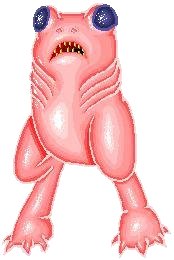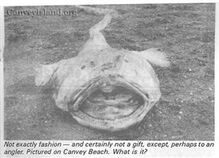The 1954 specimen was described as being 76cm (2.4ft) long with thick reddish brown skin, bulging eyes and

 Added by Azelf5000
Added by Azelf5000
 Added by Azelf5000
Added by Azelf5000http://cryptozoologycryptids.wikia.com/wiki/Cryptid
http://en.wikipedia.org/wiki/Canvey_Island_Monster
Some have speculated that the specimens may have been some type of anglerfish, whose fins had been mistaken for feet, while others have come to a more likely conclusion, that the specimens may have been frogfish, which do in fact walk on leg-like fins, have bulging eyes, and take on a variety of colours including reddish brown.[citation needed]References
In 1999, Fortean journalist Nicholas Warren carried out an investigation into the 1953-54 sightings. He was unable to locate any official records at the Plymouth Marine Biology Association Laboratory or the National Rivers Authority identifying the creature as being a known or unknown specimen, but was able to find accounts from locals who believed the creature was an anglerfish. [2] This determination was later seconded by Alwyne Wheeler, former ichthyologist for the Department of Zoology at the British Natural History Museum, who put forward that the creature was an anglerfish whose pronounced fins had been incorrectly described as being hind legs. [2]
The point is moot as both frogfish and monkfish (another candidate) are actually also anglerfishes and the identification as an "Anglerfish" actually covers all bets. Best Wishes, Dale D.
 |
| Frogfish include a pink phase |

From Monster Hunt (The Leviathans, Tim Dinsdale, 1966 and 1976) in Chapter 4, "monster, Mystery or Mermaid", "Oddity No. 2" on page 144 includes the following case:
Early July 1833
In the presence of Arthur Nicholson of Lochend, J.P. -- William Manson, Daniel Manson, John Henderson, residing in Cullivoe in the parish of North Yell, who being sworn deposit -- That, in the beginning of July last, they at the deep-sea fishing from 30 to 60 miles from land, and about midnight took up a creature attached by the back of the neck to a hook, which was about 3 feet long, and bout 30 inches in circumference at tje broadest part, which was across the shoulders. From the navel upwards it resembled a human being -- had breasts as large as those of a woman.
Attached to the side were arms about 9 inches long, with wrists and hands like those of a human being, except that there were webs between the fingers for about half their length. The fingers were in number and shape, like those of a man. The little arms were close on the outsides of the breasts and on the corner of each shoulder was placed a fin of a round form which, when extended, covered both the breasts and the arms.
The animal had a short neck, on which rested a head, about the length of a man's but not nearly so round; and somewhat pointed at the top. It had eyebrows without hair, and eyelids covering two small blue eyes, somewhat like those of a human being -- not like those of a fish. It had no nose, but two orifices for blowing through. It had a mouth so large that when opened wide it would admit a man's fist. It had lips rather thicker than a man's of a pure white color. There was no chin, but they think the lower jaw projected a little further than the upper ones. There were no ears.
The whole front of the animal was covered with skin, white as linen, the back with skin of a light-grey color, like a fish. From the breasts the shape sloped towards the tail close to which was only about 4 inches in circumference. The tail was flat, and consisted of two lobes which, when extended, might be 6 inches together in breadth, and were set at right angles with the face of the creature; it resembled the face of a halibut.
The animal was very nearly round at the shoulders. It appeared to have shoulder bones and a hollow space between them. The diminution of size increased most rapidly from the navel, which might be 9 inches below the breasts. There was between the nostrils a thing that appeared to be a piece of gristle about 9 inches long, and which resembled a thick bristle. There was a similar one on each side of the head, but not so long, which the animal had the power of moving backwards and forwards, and could make them meet on top of the skull.
When the men spoke the animal answered, and moved these bristles, which led them to suppose that the creature heard by means of them. They did not observe what sort of teeth the creature had, nor the parts of generation. There was no hair upon any part of its body which was soft and slimy.
There is an old opinion among fishermen that it is unlucky to kill a mermaid and therefore, after having kept it in the boat for some time, they slipped it.
All of which is the truth, so help me God."
A man who interviewed the boat's skipper as well as the crewmen forwarded an account to Edinburgh University's Natural History Department:
"Not one of the six men dreamed of a doubt of its being a
mermaid, and it could not be suggested that they were infulenced by their fears,
for the mermaid is not an object of terror to fishermen, it is rather a wecome
guest, and danger is apprehended from its experiencing bad treatment. . . . The
usual resources of scepticism that the seals and other sea-animals appearing
under certain circumstances operating upon an excited imagination and so
producing ocular illusion, cannot avail here. It is quite impossible that six
Shetland fishermen could commit such a mistake."
--This is once again a Monkfish or a similar anglerfish, which will be quite apparent if you try to take all of the measurements together and make a composite drawing of it. These fish are also called "headfish" because of their supposed resemblance to a human head, only this one has a nasty big wide mouth, wide enough to stick a fist into. I wish I could have a view of the underside of a Monkfish to show, but evidently they have two large rounded protrusions around the "Jowly" area underneath, and also underneath two smaller, thinner, delicate pelvic fins which the fishermen described as arms with webbed hands. The "Gristly bristles" on top are the Anglerfish "Lures" and the creature is basically only the big head part and a smaller cylindrical, tapering tail following. The description is worded such that the creature's true nature is not apparent, but the creature is about three feet long and ten inches across, with the "Wing" fins nine inches long. Where the tail began was about three inches thick, and the tail had two fins vertically placed which resembled the tail of a halibut. close to the tail was little more than an inch in breadth but the tail fins could together spread perhaps six inches. While handling it the fishermen observed no hair but only a soft slimy skin, grey on top and white on the belly. Actually the only reason to call it a "Mermaid" was because of the round "Humanlike" head and the two rounded protrusions underneath (no nipples are mentioned, either)
Best Wishes, Dale D.
--This is once again a Monkfish or a similar anglerfish, which will be quite apparent if you try to take all of the measurements together and make a composite drawing of it. These fish are also called "headfish" because of their supposed resemblance to a human head, only this one has a nasty big wide mouth, wide enough to stick a fist into. I wish I could have a view of the underside of a Monkfish to show, but evidently they have two large rounded protrusions around the "Jowly" area underneath, and also underneath two smaller, thinner, delicate pelvic fins which the fishermen described as arms with webbed hands. The "Gristly bristles" on top are the Anglerfish "Lures" and the creature is basically only the big head part and a smaller cylindrical, tapering tail following. The description is worded such that the creature's true nature is not apparent, but the creature is about three feet long and ten inches across, with the "Wing" fins nine inches long. Where the tail began was about three inches thick, and the tail had two fins vertically placed which resembled the tail of a halibut. close to the tail was little more than an inch in breadth but the tail fins could together spread perhaps six inches. While handling it the fishermen observed no hair but only a soft slimy skin, grey on top and white on the belly. Actually the only reason to call it a "Mermaid" was because of the round "Humanlike" head and the two rounded protrusions underneath (no nipples are mentioned, either)
Best Wishes, Dale D.


No comments:
Post a Comment
This blog does NOT allow anonymous comments. All comments are moderated to filter out abusive and vulgar language and any posts indulging in abusive and insulting language shall be deleted without any further discussion.